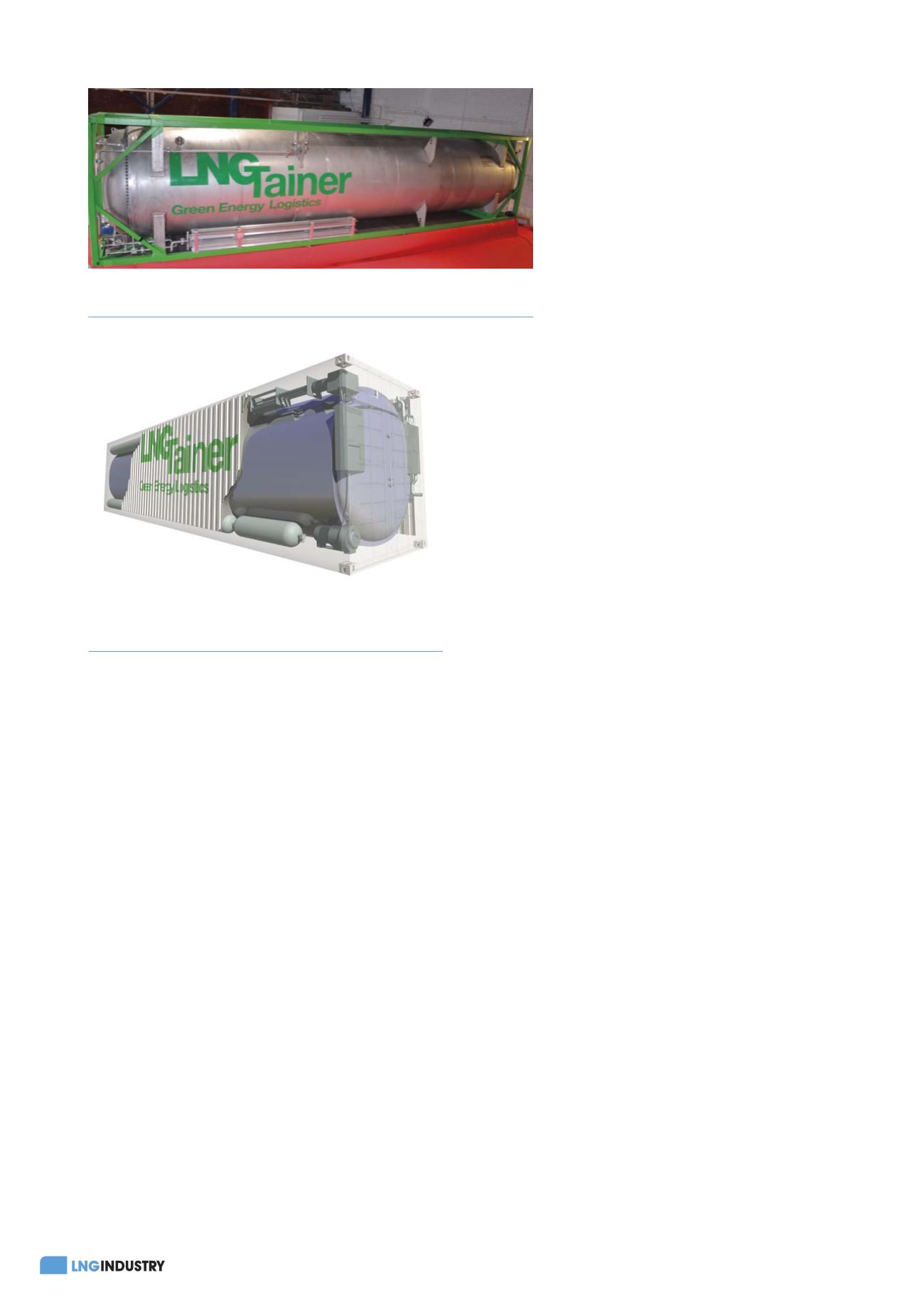
54
April 2020
standard 40 ft shipping container. These new LNG containers
are designed for flexible transportation and storage at power
plants when used for feeding gas turbines or engines.
In 2017, Finnish LNG tank manufacturer, LNGTainer,
launched a new plug-in solution based on an insulated tank
and regasification unit housed inside a standard stackable
shipping container. Approved by Lloyd’s Register, this
container-based tank is suitable for transport by road, rail and
sea.
The tanks have a 60-day holding time, which allows them
to be transported to parts of the world that have not
previously made use of LNG. The current holding time is
around 40 hours. The tanks also contain integrated
regasification units with vaporisers, which means no
additional emptying methods or technologies are required.
Stainless-steel tank body
An important benefit of this tank design is its ability to
carry 15% more LNG than comparable tanks, whilst being
30% lighter. As a result of this, the tanker boasts the largest
capacity in its class, with a maximum payload of 21 t.
This is thanks to the selection of Outokumpu’s austenitic
stainless-steel grade Supra 316plus for the inner lining of
the tank (austenitic referring to the steel’s microstructure).
Supra 316plus is an enhanced version of the popular
316L/4404 austenitic stainless-steel grade and is typically
used in process and transport tanks, water treatment systems,
heat exchangers and architectural applications.
Although LNGTainer first considered aluminium as the
material for the inner tank, the stainless-steel alloy has better
properties at low temperatures. Its strength and
ductility improve when the temperature drops a
low as -196°C and this enables thinner gauges.
This translates to thinner tank walls and
therefore a more lightweight tank. In turn, this
leads to savings in the fuel and energy required
to transport the tank, with resultant savings in
costs, as well as in carbon footprint.
Moreover, the lightweight inner tank has
further cost-saving benefits for the transport of
LNG. Having thinner walls means that the tank
cools down more quickly than other tanks. This is
an important factor in LNG transport. Before
filling, tanks must be chilled to avoid thermal
shock to the tanks. LNGTainer’s tanks can be chilled and ready
for filling within two hours, compared with up to 48 hours for
other tank models that have thicker walls. This enables
operators to get their tanks on the road faster, maximising
availability and reducing costs.
LNGTainer’s tanks are designed for mass production to
keep up with anticipated growth, which, according to BP
industry estimates, will require new containers to the tune of
3000 per year. The system’s scalability allows for the handling
of both small and large quantities of LNG. The tanks have
ADR/RID and IMDG standard certifications, approved by
Lloyd’s Register.
In addition, the tanks feature monitoring that can be
integrated into enterprise resource planning (ERP) software.
This enables operators to track their fleet in real-time.
With the tank containers’ larger capacity, fast cargo
handling and low weight, handling costs are reduced
significantly. Furthermore, the container-based design of the
tanks enable the use of existing freight container handling
equipment in harbours, at sea and on land.
Lifecycle cost of stainless-steel
Regardless of the grade, stainless-steel is an ideal material
for transportation of bulk chemicals, whether it is deployed in
a cargo tank for a marine chemical tanker, a tank container, a
reusable mini-tank or a storage tank at a terminal. Selecting
the correct type of stainless-steel depends on the unique
requirements of the container, for example: the chemical to
be transported, the external environment and the loading
conditions. When the optimum grade is selected, it will
provide a long life with low maintenance requirements and
the operator will be able to recover cost back at the end of
the container’s life from the scrap value of the stainless-steel.
In the case of the LNGTainer tank design, Supra 316plus
is a long-term, cost-effective material that not only offers its
aforementioned high strength and ductility at low
temperatures, but also corrosion resistance, formability and
weldability in the inner lining of LNG tanks.
Weldability
For an application like the LNGTainer, weldability is vitally
important as welds must withstand the many thermal cycles
as cargo is loaded and unloaded from the tank. A sound weld
will ensure a long life for the tank, reduce the risk of leakage
and ensure safe operations.
However, it is important to consider welding of
stainless-steel carefully as it differs to carbon steels. This is
because of the heating and cooling cycles during welding,
Figure 2.
The ductility of stainless-steel increases at low
temperatures, helping LNGTainer tanks to withstand the
cryogenic degasification process.
Figure 1.
Outokumpu’s austenitic Supra 316plus creates a strong and
lightweight inner tank.








